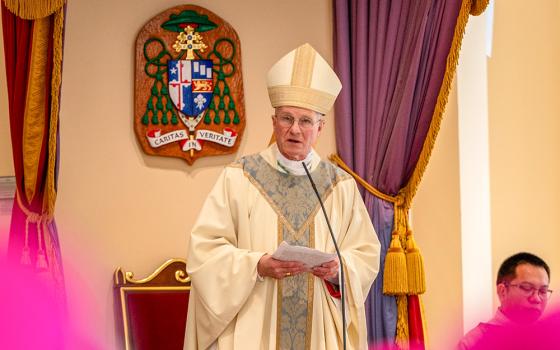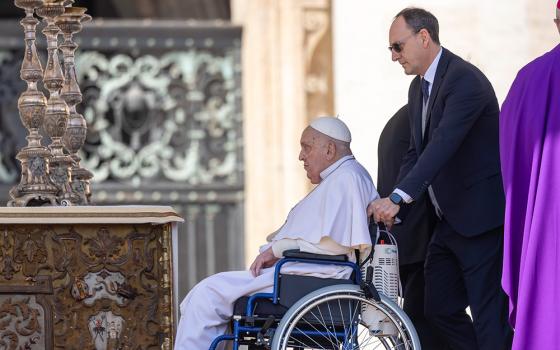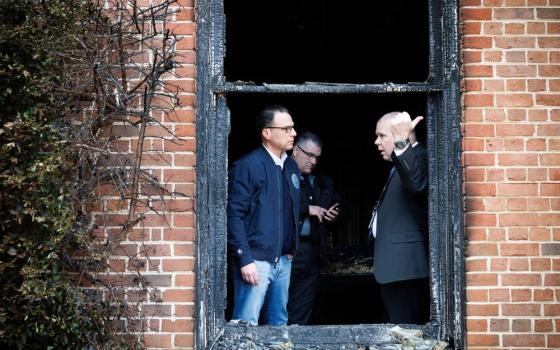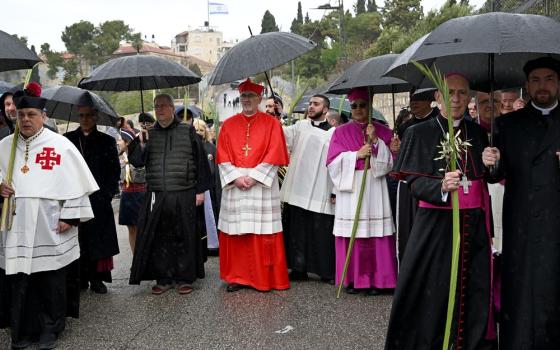
Kelly Stokes, far left, an instructor with Electricians Local 1 in St. Louis, works with student Roderick Brown from St. Mary's South Side Catholic High School in St. Louis, while Tracy Hykes, a pre-apprentice instructor, at right, looks on. (Courtesy of St. Mary's South Side Catholic High School)
In another time, if there were a reference to "vocational education" at the secondary school level in U.S. Catholicism, it would likely be about a high school seminary.
But today, some Catholic high schools are acknowledging that college may not be the ultimate path for all of their students and are teaching them skills and trades to help them find jobs right after they earn their diplomas.
One such school is St. Mary's South Side Catholic High School, an all-boys high school in St. Louis. A year ago, it began an elective pre-apprenticeship exposure curriculum for its juniors and seniors, with representatives from more than a dozen skilled trades taking their turn coming into the classroom to explain the job, the skills needed to do the job right, and how to acquire those skills.
Thirteen students took the one-semester course last fall. This fall — school started Aug. 14 at St. Mary's — 15 students are enrolled, according to Valerie Todd, the principal.
"We were the first school in Missouri to offer this pre-admission program," said Todd, who grew up near the school located in the Dutchtown neighborhood. She said the curriculum stems from the North America's Building Trades Unions.
The educational initiative has the blessing of Jake Hummel, an electricians' union member who is head of the Missouri AFL-CIO and himself a St. Mary's alumnus. The state labor federation's Missouri Works Initiative partners with St. Mary's to develop the course syllabus and arrange for guest instructors from the skilled trades to come to the classroom on their assigned weeks.

Kelly Stokes, instructor with Electricians Local 1 in St. Louis measures material with Michael Gallaway, on right, a student at St. Mary's South Side Catholic High School in the pre-apprenticeship program at the St Louis school. (Courtesy of St. Mary's South Side Catholic High School)
This is not something new at St. Mary's. "We have had over the years some kind of trade opportunities," said Todd, who has been at St. Mary's for 27 years. "We used to have electricity and HVAC classes for a while. For the last — probably since the 2019-20 school year — we had a partnership with Ranken," a 2,300-student technical college in St. Louis that offers degree and certification programs in automotive, electrical, construction, IT and manufacturing. St. Mary's students enjoyed "dual enrollment" at both the high school and Ranken, and "would go there half the day," Todd said.
While the St. Mary's South Side program appears unique, there are other Catholic educational institutions that have developed their own approach.
The Cristo Rey Network, a collection of 40 Catholic high schools nationwide with more than 12,300 students, still wants its students to go to college, but will pair its students with established professionals in a field being considered by the student as a future profession.
There are also a handful of Catholic post-secondary trade schools in operation throughout the United States: Santiago Trade School, just outside Silverado, California, the College of St. Joseph the Worker in Steubenville, Ohio, Kateri College in Gallup, New Mexico, and Harmel Academy of the Trades in Grand Rapids, Michigan.
St. Mary's isn't positioning itself as "the little school that could," although it could be seen that way. It was founded by the Archdiocese of St. Louis in 1931, as the Great Depression was reaching its nadir. Dutchtown, once a solid working-class neighborhood, "has seen better days," Todd acknowledged.
During the 2022-23 school year, the archdiocese announced it would close St. Mary's, an announcement that shocked and stunned community members, school families and alumni. Todd said the Marianist order, which had been supplying its members for decades to teach at St. Mary's, took over sponsorship of the school, which kept its doors open and now educates about 215 young men.
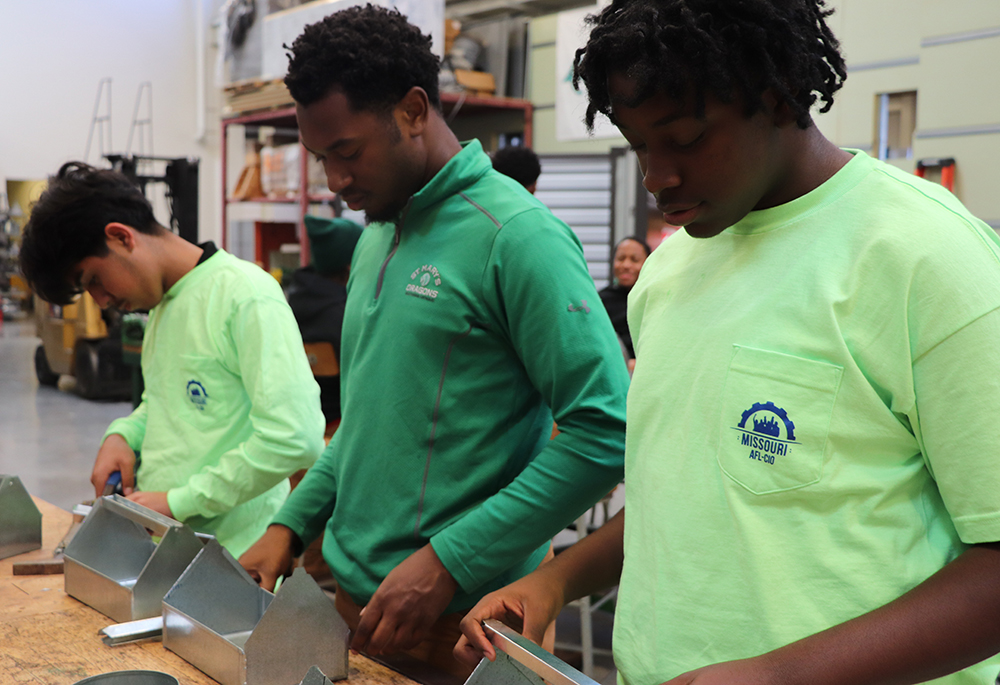
St. Mary's South Side Catholic High School students (from left to right) Omar Navarette, Roderick Brown and Samuel Wynn work with sheet metal in class during the 2023-2024 school year. (Courtesy of St. Mary's South Side Catholic High School)
"This particular program came to fruition when the archdiocese said they were going to close us," Todd said. "I don't know if we were going to be able to do it if we were still with the archdiocese — giving our students one other option to help them prepare," because as she pointed out, there are many routes to success after high school.
Tracy Hykes, recruited by Hummel to teach the course at St. Mary's, just as he was getting ready to retire after working as a member of the sheet metal and related trades union local in St. Louis since 1985.
Since 1999, Hykes had been teaching in the union's apprenticeship program, primarily on occupational safety and health matters as well as tutoring, in his words, "all the kids who took the sheet metal test and maybe failed a certain part of it, so they could pass it" next time.
'This particular program came to fruition when the archdiocese said they were going to close us,' Valerie Todd, the principal, said. 'I don't know if we were going to be able to do it if we were still with the archdiocese — giving our students one other option to help them prepare,' because as she pointed out, there are many routes to success after high school.
The St. Mary's program is part of the Missouri AFL-CIO's "BUD" program, an acronym for Building Union Diversity.
The curriculum "gives them some math, some plane readings. It gives the reasons behind unions. They get educated on unions," Hykes said. "Then we go out into the field. We go to different unions and I get them familiar with each particular union and what they do. And they also get a 10-hour OSHA [federal Occupational Safety and Health Administration] card."
That card gives students a leg up in the apprenticeship application process, which for most skilled trades lasts four years. "If they decide to get into the union, the union recognizes they've got some training. They're familiar with what they need to become a sheet metal worker or a pipefitter," Hykes said. One of last year's students, he added, used his OSHA card to begin his apprenticeship as a carpenter. And he is getting paid while he's in training.
The St. Mary's class follows the same formula he used in his apprenticeship teaching, Hykes said, but aimed at high schoolers. "Kids want to be kids, but at the end of the day I love it."
Advertisement
Samuel Wynn was in the inaugural class of students. Wynn, who graduated this spring, said both his parents and one of his grandmothers went to college, but he said he was "really always interested in hands-on work."
He said in the high school program he learned about machine operators, carpentry and pipefitting and one trade he realized he was not interested in was bricklaying. "They seem cool, but it's a lot of manual-focused work, you have to get on your hands and knees and place every tile. That wasn't for me. But the finished product is so nice, I've got to give them props. It's a tedious job, and I don't have the patience for it."
Taking the class "definitely helped, it helped a lot," Wynn said, adding that it showed him "what I needed, what I didn't need, what I would be up against, the weather having an impact on the job."
Hykes, in the second year of a four-year term as an elected member of the St. Louis Board of Education, said, "We're trying to bring this to the St. Louis public schools. But it's a little bit harder," he added. "But we're working on it. We're working on it."

